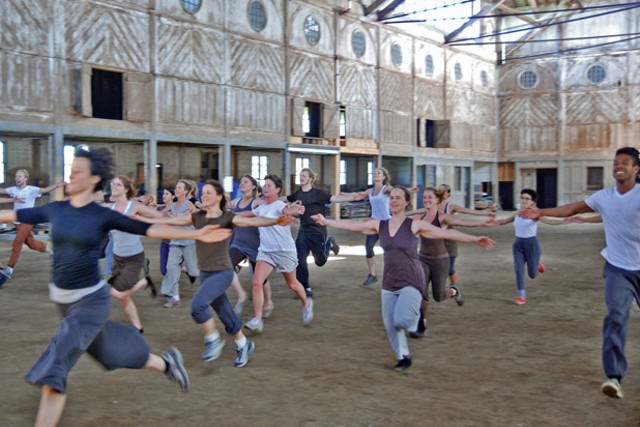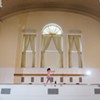Published October 12, 2011 at 11:53 a.m.
Hannah Dennison has known for some time that when she returned to the Vermont dance scene, it would be to do something grand. The veteran choreographer, who created ambitious, often site-specific dance works in the Burlington area for about 20 years, dropped out a decade ago.
And then, in 2009, Dennison learned that the German choreographer who was her idol, Pina Bausch, had died. Dennison recalls that she wept — and knew exactly what to do: She would rejoin the local dance community with a large-scale work in honor of Bausch, who was known for her viscerally intense dance-theater works. “This is my tribute to her,” says Dennison. “I’m giving back to her.”
On a recent afternoon, nearly 40 Vermont dancers turn out to an audition for “Dear Pina” in the cathedral-like Breeding Barn at Shelburne Farms. Dennison doesn’t intend to turn many people away; she simply wants to run the dance in the barn and make sure the dancers are a good fit. The work will debut in June 2012, copresented by the Flynn Center for the Performing Arts and Montpelier’s Contemporary Dance and Fitness Studio (CDFS).
For the choreography, Dennison has partnered with Amy LePage, who helped form the Montpelier Movement Collective, and Hanna Satterlee, director of professional programming at CDFS. “I could not do this piece without them,” Dennison says.
Emily Boedecker, a dancer and deputy state director for the Nature Conservancy, is working with Dennison to promote the piece. When Boedecker first walked into the Breeding Barn, she says, she imagined staging a medieval joust there.
What Dennison has planned is similarly imposing. As the dancers move in unison across the dirt floor, their sneakered feet make great scraping sounds, enhancing the minimalist music composed by Dennison’s partner, David Severance. The barn is enormous — 418 by 107 feet — and the choreography is athletic enough to fill it. The dancers run, kick and twirl with outstretched arms, exhaling audibly in simultaneous bursts. One vigorous sequence stirs up some downy white feathers, which float down from the rafters and scuttle across the floor.
In the past, Dennison built her works around untrained community performers. Not this time. “This is the piece I’ve been waiting to do my entire career,” she says. “I don’t feel like I need to compromise.” Plus, she has exactly 17 rehearsals — one a week between February and June — to get this thing together. “I’m asking a lot of these performers,” she admits.
If Dennison can meet her roughly $140,000 fundraising goal, she’ll pay the dancers for their work. “I feel really strongly that artists should be paid for the training and skills that they bring to their job, just like plumbers and architects and executives,” she says.
Dennison began to fall in love with Bausch even before she saw her company, Tanztheater Wuppertal, perform. In the early ’80s, Dennison pored over the German dance magazines featuring Bausch, unable to read the text but mesmerized by the photos. At 36, Dennison took a creative pilgrimage to Germany to see the work of choreographers who inspired her: Bausch, Reinhild Hoffmann and Susanne Linke.
Bausch moved her the most. Dennison traveled to Bausch’s home theater in Wuppertal to see “Seven Deadly Sins” — a work full of what the New York Times called “colorfully harsh moments.” “I was floored,” says Dennison. The dancing was powerful, she continues, but it was the startling theatrical elements that captivated her: one performer roughly brushing another’s hair; a woman standing “like a tree, screaming her head off” and then falling to the ground, straight as a board. Are they faking this? Dennison remembers wondering.
In “Dear Pina,” Dennison has incorporated some direct nods to Bausch’s harsh theatrics. At the audition, she gathers six dancers around her to participate in a vignette section. She asks the first dancer to hoist an unwieldy stool on her back and carry it that way down the length of the barn. “If it’s difficult and uncomfortable, that’s good,” she says. Dennison turns to the next dancer: “Would you like to fool around with suitcases?”
She instructs the third to walk downstage with a ball of string, “and if you cry, that’s fine.” The string, Dennison explains, was used in her “Waterfront Project,” an art event that took place every Sunday of 1997. “This string has a lot of memory,” she says. “It’s been a long way.”
She turns to the next dancer and asks, “How loud can you yell?” Finally, Dennison asks one of the few male dancers to undo a female dancer’s ponytail, sit her in a chair and brush her hair. “She may fall out of the chair,” suggests Dennison.
The vignettes, all happening at once, create the emotionally tense and slightly hallucinogenic atmosphere for which Bausch was known.
Dennison’s friends Lisa Schamberg and Pat Robins of Burlington, who’ve pledged to support the project, look on from a row of folding chairs. The barn, Robins explains, was the largest free-span building in America until 1939.
When Shelburne Farms acquired the Breeding Barn from Shelburne Museum in 1994, “it was in really bad shape,” says Shelburne Farms president Alec Webb in a later interview. The asbestos-shingle roof was replaced and the structure stabilized, but more work needs to be done. “It’s going to sit there for a bit while we get organized for the next step,” Webb says.
In the meantime, Shelburne Farms is experimenting with the space, hosting one-time events there, such as Dennison’s work. The audition is the ensemble’s last chance to dance in the barn until dress rehearsals begin in June.
They’re taking full advantage of it. Behind the row of onlookers, an older man and woman practice walking in slow motion on sneakers glued to wooden blocks. They are holding hands, and each carries a gnarled cane in the other hand.
These dancers, Sharyl Green and Peter Lackowski, play Dennison’s “Tall, Dignified Couple.” For much of the work they sit at a banquet table that’s draped in a yellow cloth and adorned with a red plate of lemons. Green is dressed in a long, yellow dress and fur stole, which once belonged to Dennison’s mother; Lackowski wears a navy-blue suit.
The Tall, Dignified Couple, Dennison says, is what makes the piece her own. She never saw Bausch incorporate anything like it — an element that changes so slowly, you need look at it only intermittently. But in that enormous barn, Dennison wants a contrast to the big movement of the ensemble. And she wants height — in their block sneakers, Green and Lackowski are close to seven feet tall.
In one dance, the entire ensemble moves slowly and sadly downstage, while the Tall, Dignified Couple progress in tiny steps upstage, their backs to the audience, until they disappear from view. Next to the couple, Dennison says, the other ensemble members are “mere mortals down there on the dirt with this huge space soaring above us.”
The audition draws to a close. Sunlight through the giant clerestory windows casts long spotlights on the dirt floor. When the music ends, the eaves fill with the soft coos of roosting mourning doves.
For more info on "Dear Pina," visit hannahdennison.org.
Want to see for yourself?
Catch a preview of Dennison’s work in progress at “Eat My Art Out Fall 2011,” a semiregular choreographers’ showcase, on Friday, October 21, at 7 p.m., at Burlington Dances in the Chace Mill, Burlington. Donations suggested. Info, 863-3369.
More By This Author
Speaking of Dance,
-

Seniors Dance With Joy at St. Johnsbury's Quahog Dance Theatre
Jan 17, 2024 -

Soundbites: Soundbites: DJ Malcolm Miller's Second Act
Dec 13, 2023 -

Middlebury Choreographer Christal Brown's 'What We Ask of Flesh' Explores the Burdens We Carry in Our Bodies
Nov 1, 2023 -

A Dance Theater Work Foregrounds Climate Crisis at WRJ Fest
Jul 12, 2023 -

New Works by Paula Higa Dance Explore Themes of Migration and Identity
May 3, 2023 - More »
Comments
Comments are closed.
From 2014-2020, Seven Days allowed readers to comment on all stories posted on our website. While we've appreciated the suggestions and insights, right now Seven Days is prioritizing our core mission — producing high-quality, responsible local journalism — over moderating online debates between readers.
To criticize, correct or praise our reporting, please send us a letter to the editor or send us a tip. We’ll check it out and report the results.
Online comments may return when we have better tech tools for managing them. Thanks for reading.















































